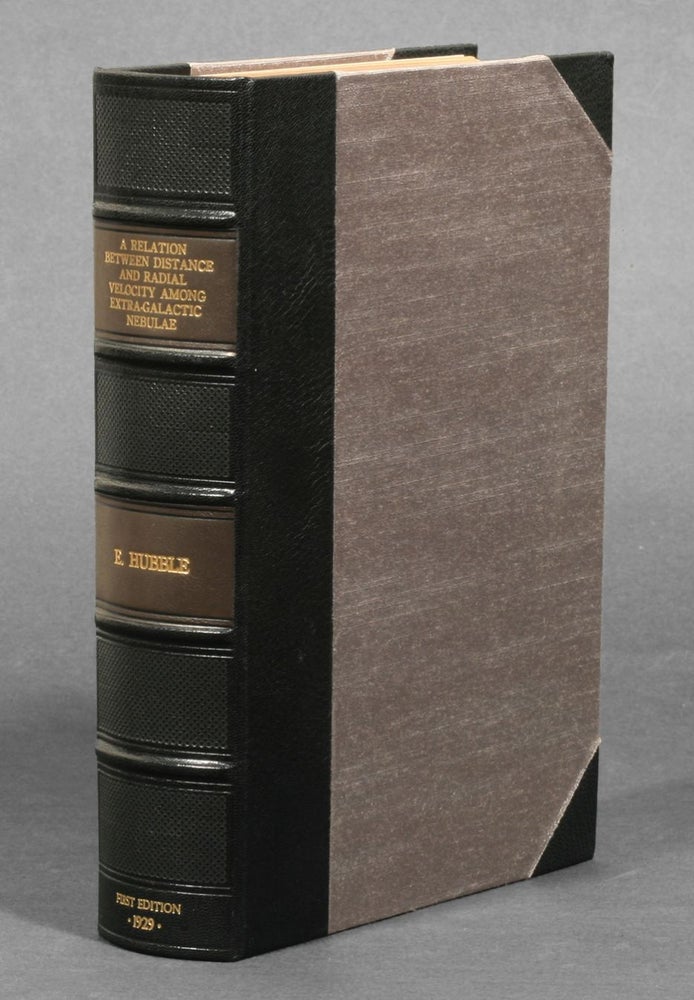A Relation between Distance and Radial Velocity among Extra-Galactic Nebulae
Hubble's discovery “made as great a change in man’s conception of the universe as the Copernican revolution 400 years before." -Dictionary of Scientific Biography
FIRST EDITION OF HUBBLE'S DISCOVERY OF THE EXPANSION OF THE UNIVERSE.
Edwin Hubble’s landmark paper documented what would later become known as Hubble’s Law, stating that there is a proportional relationship between a galaxy’s recession velocity and its distance from the Earth. One of the most profound discoveries in science, Hubble’s data provided evidence of an expanding universe, thereby providing the essential argument for the Big Bang theory, proving the natural implications of Einstein’s General Theory of Relativity, and ultimately allowing for the determination of the age of the universe.
By the early 1920’s advances in spectroscopy had allowed for the observance of a curious “redshifting” of galaxies, indicating that the majority of galaxies seemed to be receding from the Milky Way. The evidence was rudimentary and inconclusive and “various weird and wonderful explanations were put forward, but there was no consensus. The case of the receding galaxies remained a mystery until Edwin Hubble applied his mind and his telescope to the problem. When he entered the debate he saw no point in wild theorizing, particularly when the power of the mighty 100-inch Mount Wilson telescope held the promise of new data.”
To solve the redshift mystery, Hubble and his assistant Milton Humason “divided the work between them. Humason would measure the Doppler shifts of numerous galaxies, and Hubble set about measuring their distances... By 1929 Hubble and Humason had gauged the redshifts and distances for forty-six galaxies.” Using only the twenty that were within an acceptable margin of error for their measurements, Hubble plotted velocity versus distance for each galaxy. “In almost every case the galaxies were redshifted, implying they were receding. Also, the points on the graph seemed to indicate that the velocity of a galaxy strongly depended on its distance. Hubble drew a straight line through the data, suggesting that the velocity of a given galaxy was proportional to its distance from the Earth...
“If Hubble was right, the repercussions were immense. The galaxies were not randomly dashing through the cosmos, but instead their speeds were mathematically related to their distances, and when scientists see such a relationship they search for a deeper significance. In this case, the significance was nothing less than the realization that at some point in history all the galaxies in the universe had been compacted into the same small region. This was the first observational evidence to hint at what we now call the Big Bang. It was the first clue that there might have been a moment of creation.” (Simon Singh, Big Bang).
Two additional implications of Hubble’s discovery were that, through the use of Hubble’s Law and the accurate determination of Hubble’s proportionality constant, the age of the universe could be determined; also, it confirmed the natural result of Einstein’s General Theory of Relativity which predicted an expanding universe (before Einstein added his “cosmological term” to prevent this seemingly impossible conclusion). After Hubble’s discovery proved the unnecessary and incorrect inclusion of the forced “cosmological term” in Einstein’s theory, Einstein sought out Hubble to congratulate him, later calling his cosmological term “the biggest blunder he ever made in his life.”
In Proceedings of the National Academy of Sciences, Vol. 15, No. 3. [Washington, D.C.]: Carnegie Institution, 1929. The entire volume offered. Quarto, elegant modern three-quarter morocco. A few stamps to outer corner of a few pages (none to Hubble paper). Binding and Hubble paper in fine condition.
Check Availability:
P: 212.326.8907
E: michael@manhattanrarebooks.com

